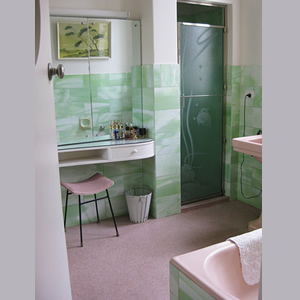- 17 reads

The biggest culprit of unsustainability in the bathroom comes from excessive water usage, but in dichotomous ways. To truly make your bathroom greener, it is vital to manage the water coming in through the pipes, as well as water that flows out, whether it be through non-low flush toilets, or through the vapor from hot water. You can combat this with low flow showerheads and toilets, and faucet aerators. The showerhead and the faucet aerator both maintain the current feel of water pressure, but use much, much less water. However, the challenge does not simply end with these improvements, as the walls of the room must also be able to withstand the constant barrage of water and humidity, in conjunction with an exhaust fan that can work quietly and efficiently to clear the space of excess humidity. You will also want to invest in durable surfaces that can stand up to time.
Before starting your Bathroom Remodeling Project, make sure you consider the desired function of the room, the existing conditions that one will have to deal with, the scope of the project, the size of the room, and the layout and space planning. Here it is in a little more depth:
Function
A bathroom remodeling project can be enacted for a variety of reasons. And whether it is to fix a leak and its subsequent structural damage, to make the room more convenient, to grow with a family, to improve aesthetics, or just to upgrade the appliances and fixtures; the project will be an opportunity to consider purchasing green products in the face of more luxurious ones that serve a less vital function.
Existing Conditions
Consider the problems you face when going into the project to best be able to overcome them. For instance, the project could be driven by mold or moisture that has eroded the sanctity of the bathroom, or the electrical wiring for light fixtures and outlets could be old and in dire need of replace, and still others may wish to simply enlarge the space of the room. Think about what your goals are before you settle on a strategy.
Scope
When making upgrades and changes to the bathroom, it is helpful to consider improvements to the homes envelope as well. You may need extensive plumbing and wiring in the bathroom, and if you are considering further home remodeling projects, think about how your future goals for the whole house will be affected by the bathroom upgrade. Also, if you design the bathroom to be friendly for the elderly (i.e. higher stalls, wheelchair accessible), you will be able to inhabit the home for a longer period of time.
Size
The larger your end goal, the more expensive and time consuming your project will be. Consider analyzing the current space, and refiguring the location of things to increase the functionality of your bathroom without disrupting other rooms in the house. Thinking of the home as an organism, instead of an object will lead one to understand that the more radical the change, the less likely you are to understand the full impact of the improvements until it is too late.
Layout and Space Planning
Before you get started on any major bathroom remodeling project, consult with an expert contractor who is familiar with the green technology improvements over the past few months. Not only will your options be clearer with the help of an expert, but he may also be able to point you in the right direction for tax credits on qualified items, which can really enhance the value of an energy efficient upgrade.
With proper planning, you should be able to come to a solution that preserves or enhances the aesthetics, while improving resource efficiency.
The information found in this article has been provided by the ReGreen Program, which is the result of the American Society of Interior Designers’ Foundation and the U.S. Green Building Council partnering on the development of best practice guidelines and targeted educational resources for sustainable residential improvement projects. This program will increase understanding of sustainable renovation project practices and benefits among homeowners, residents, design professionals, product suppliers and service providers to build both demand and industry capacity. Learn more at ReGreenProgram.org.
GREENandSAVE.com is a free resource for anyone that wants to save energy, money, and the environment. The articles, product reviews, online tools, and return on investment calculations are researched from a diverse range of public and private sector sources. Overall, the company is passionate about saving money as well as creating healthy homes, offices, and lifestyles.
For a better idea of which improvements to your home will save you the most money the fastest, take a look at GREENandSAVE’s Return on Investment Table for your next Home Remodeling project. Or, consider taking a career in the rapidly expanding Green Industry with the EcoAcademy, which is training people across the country for Green Collar Jobs.

